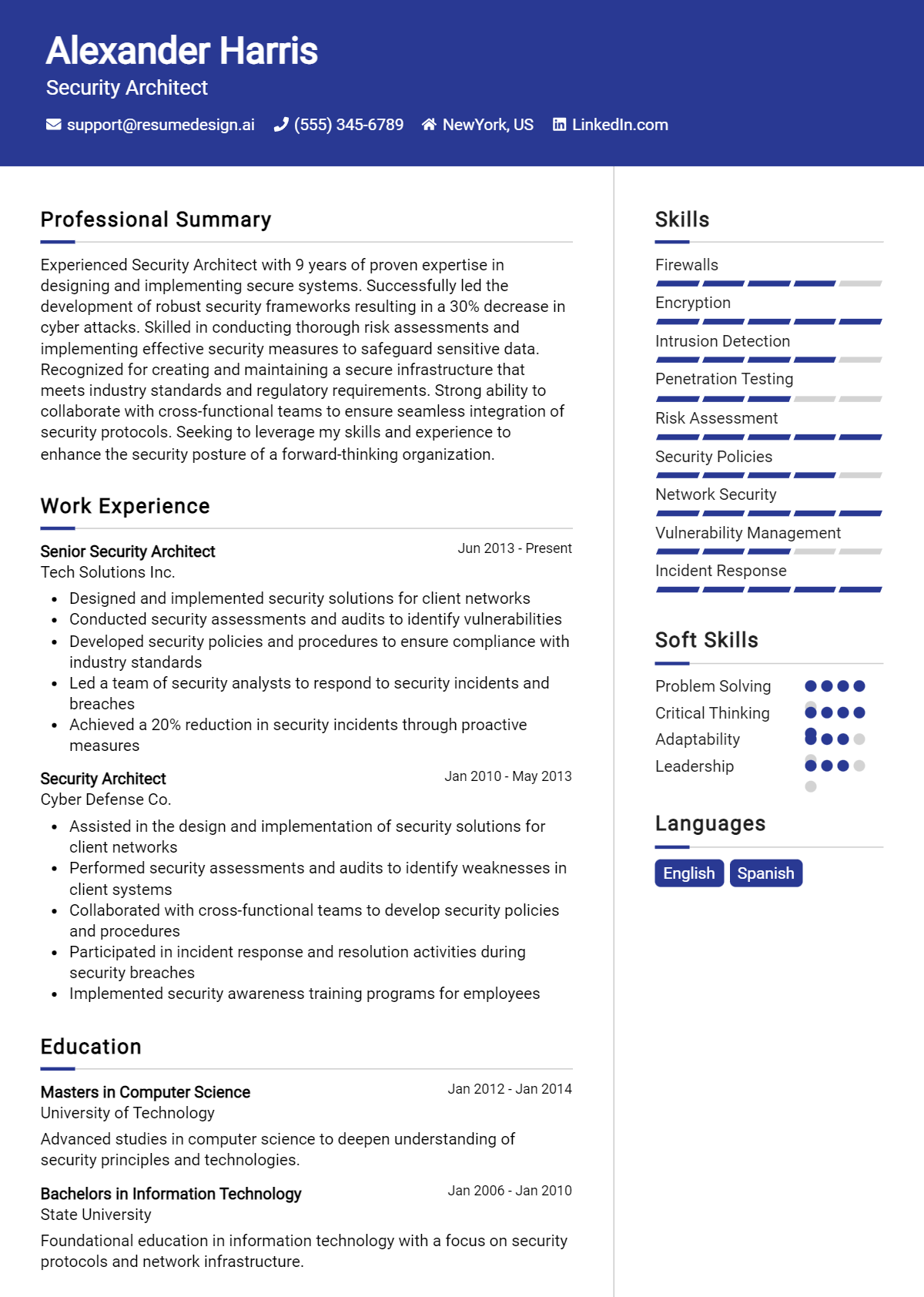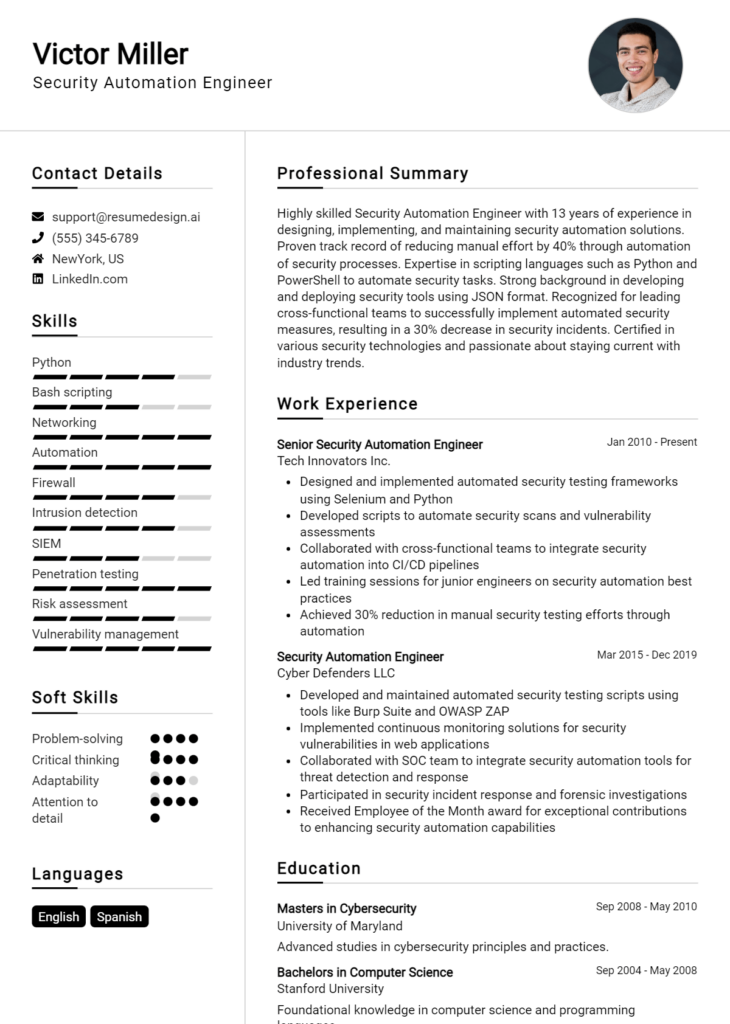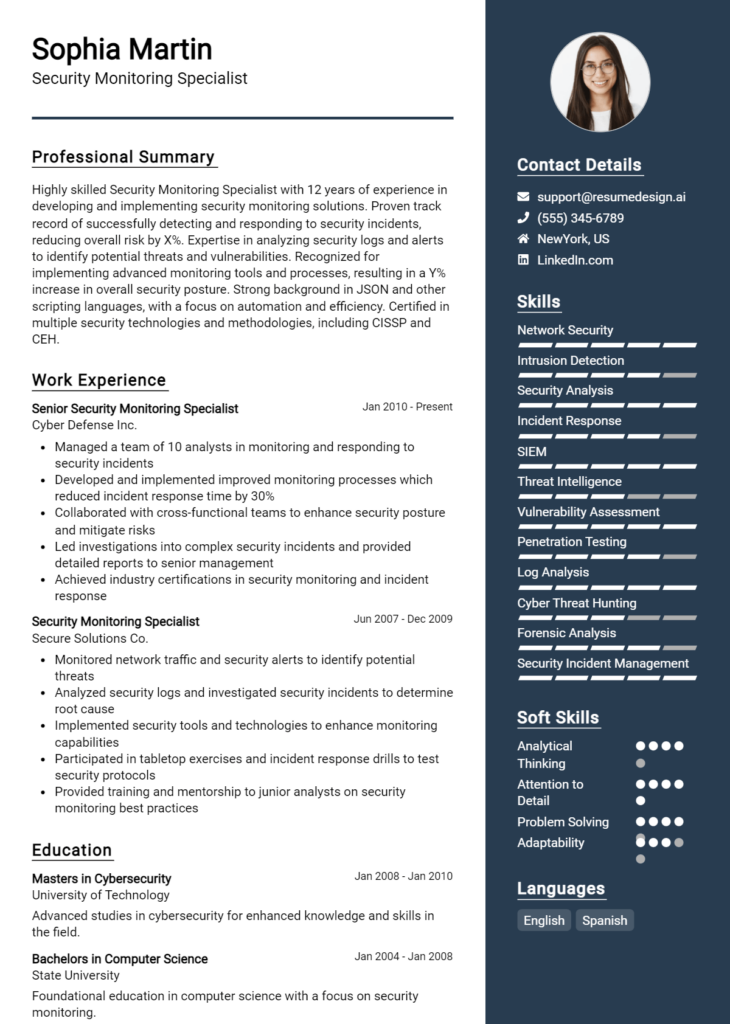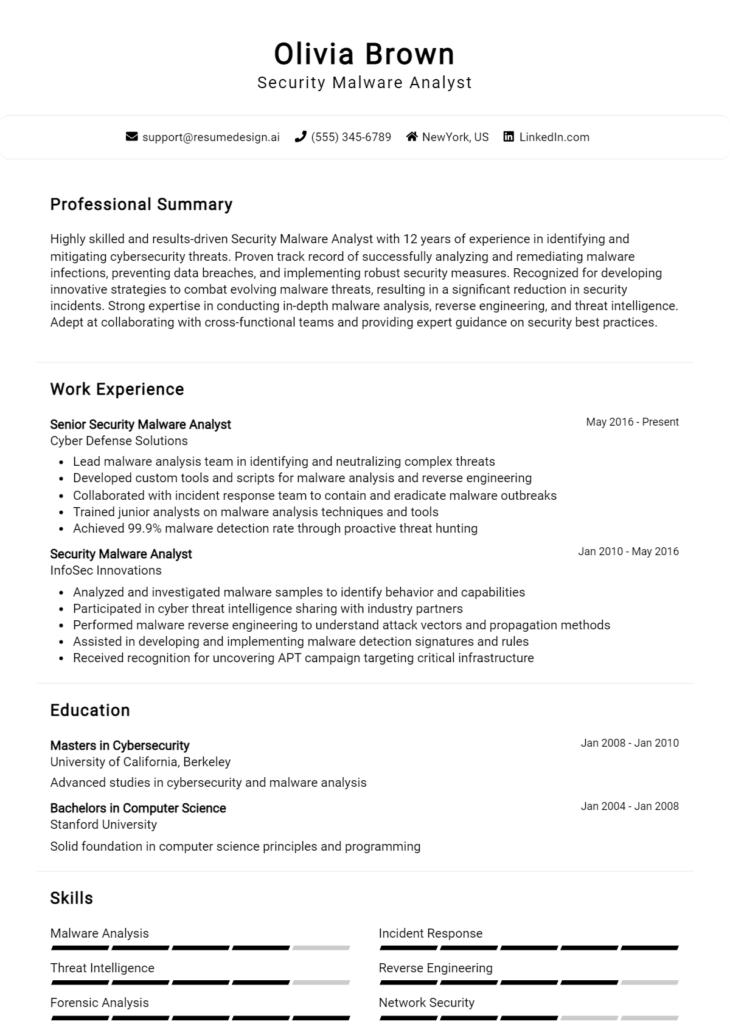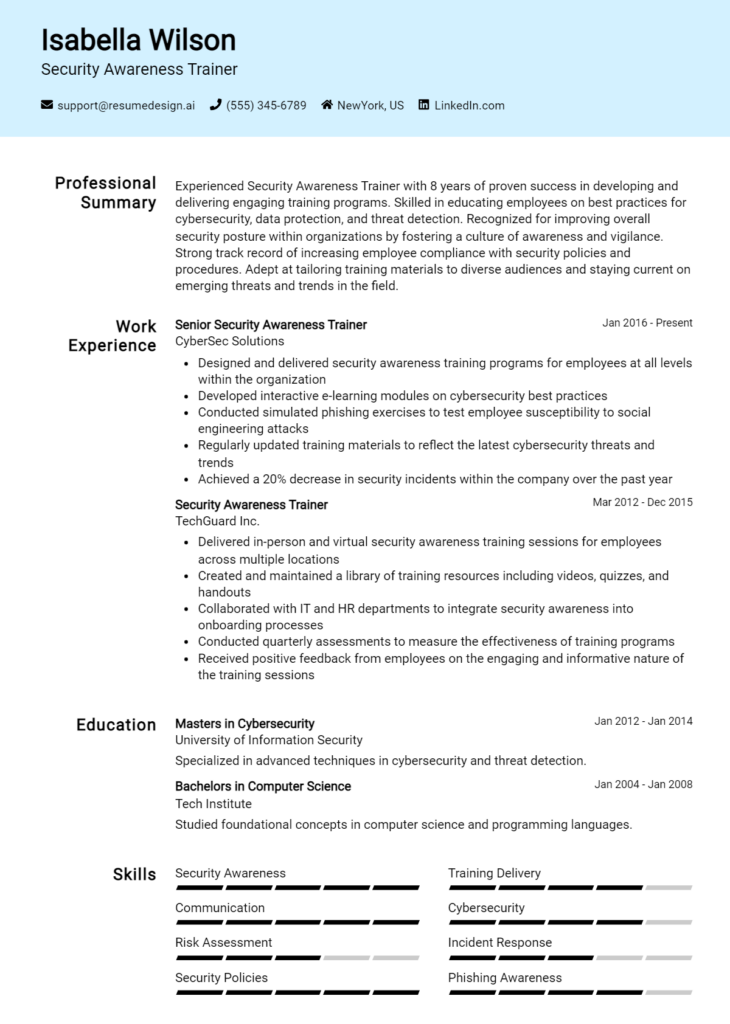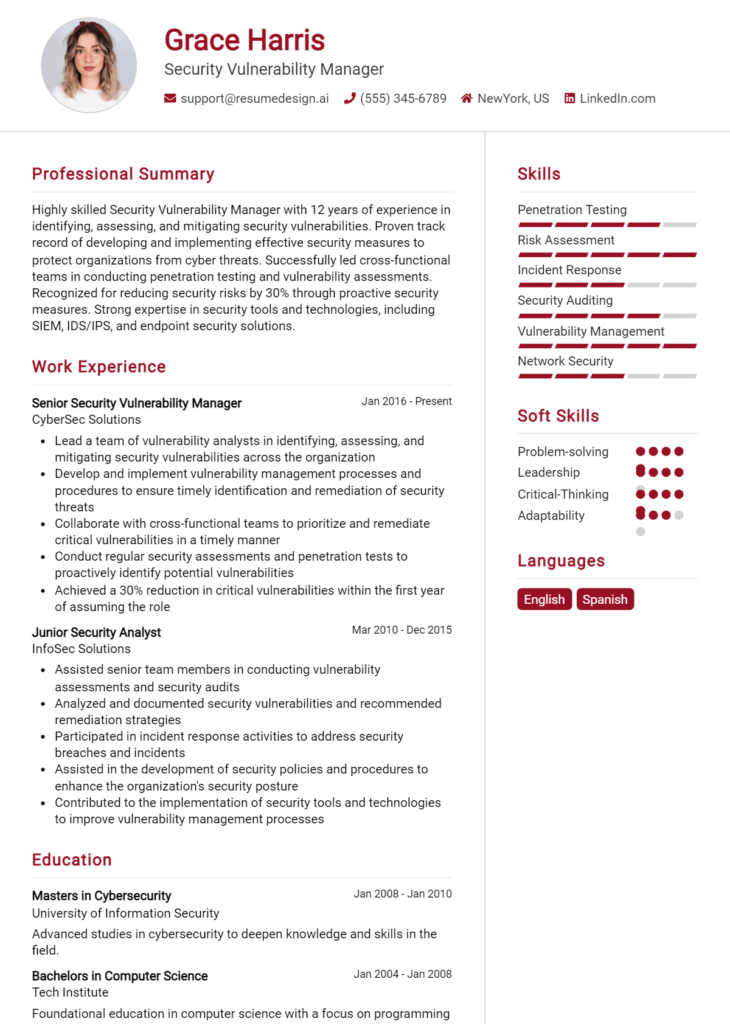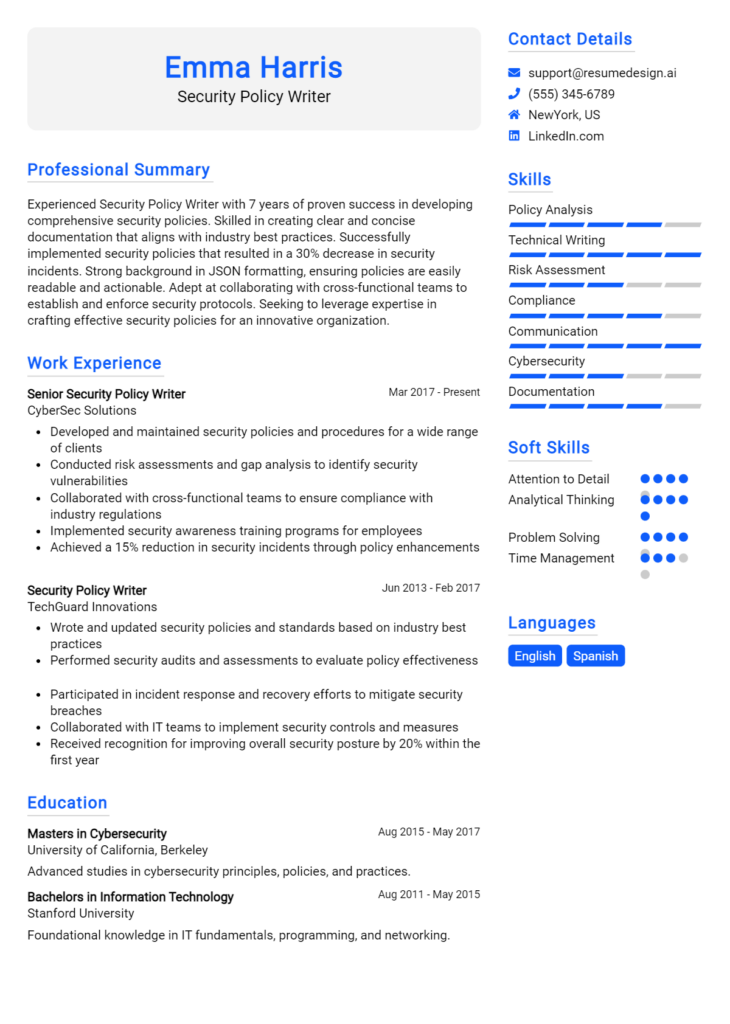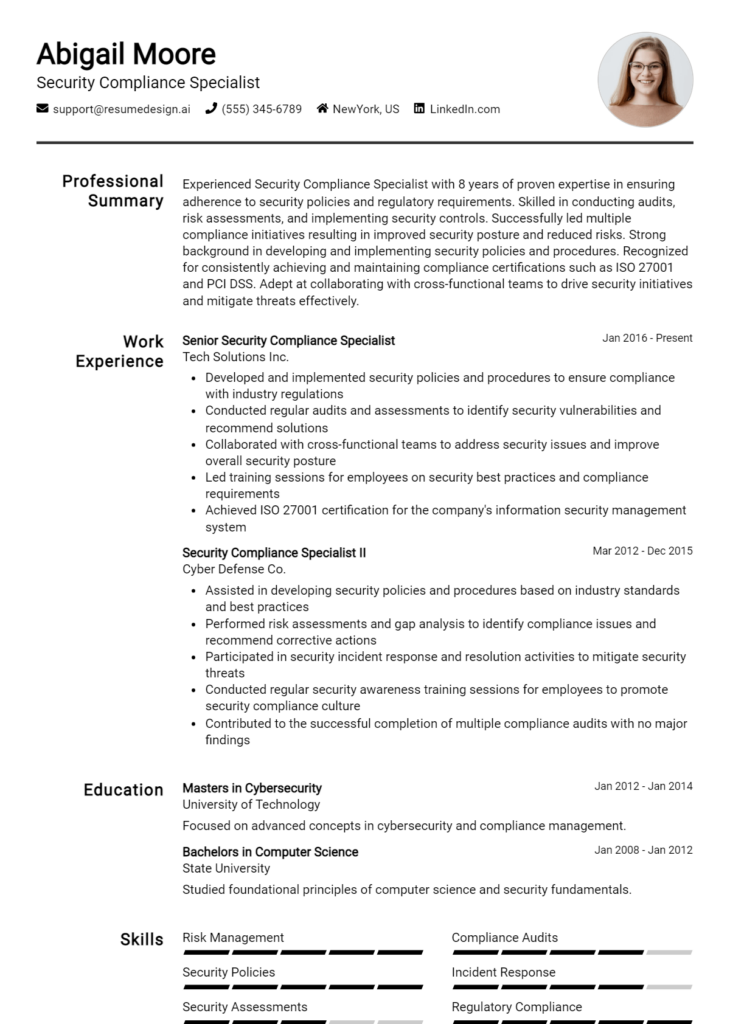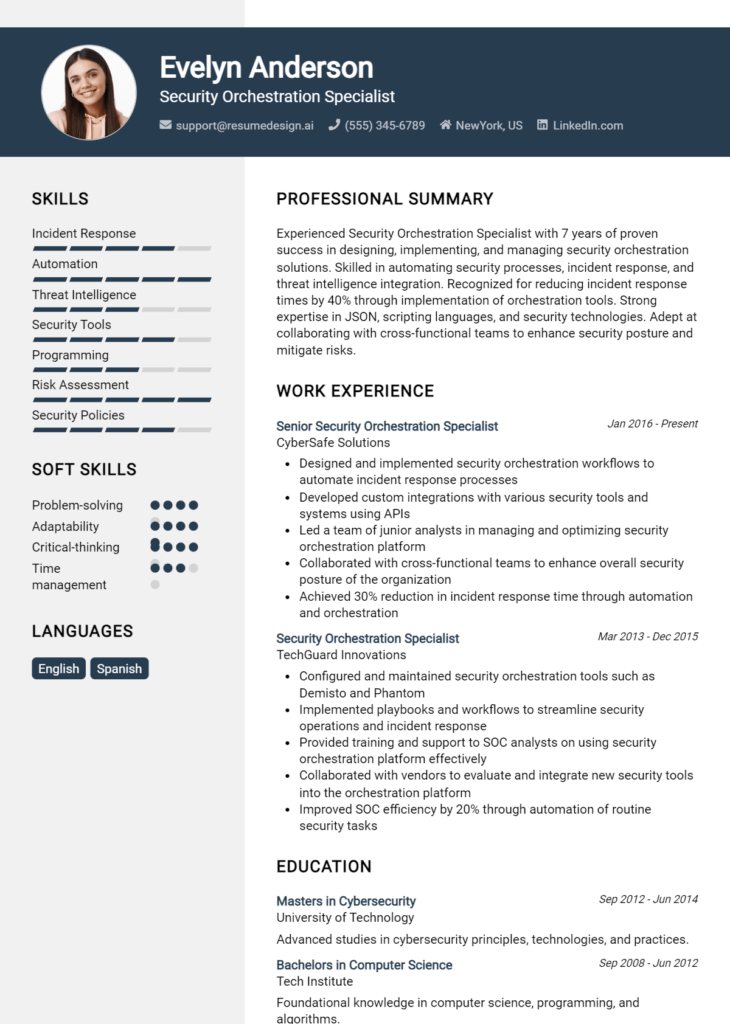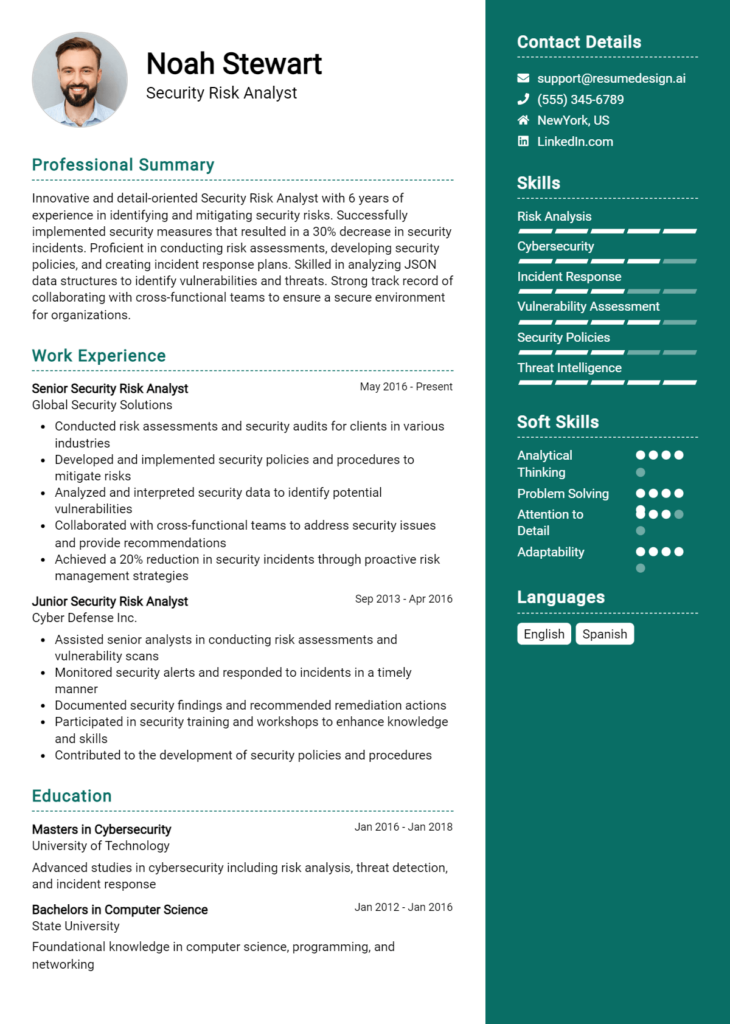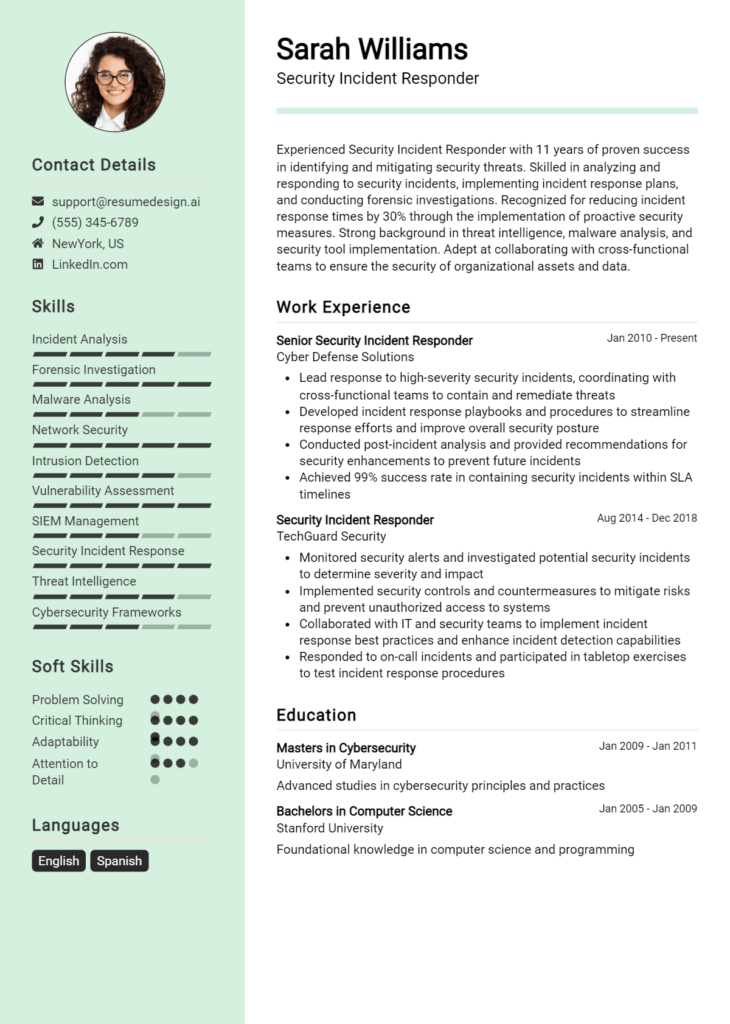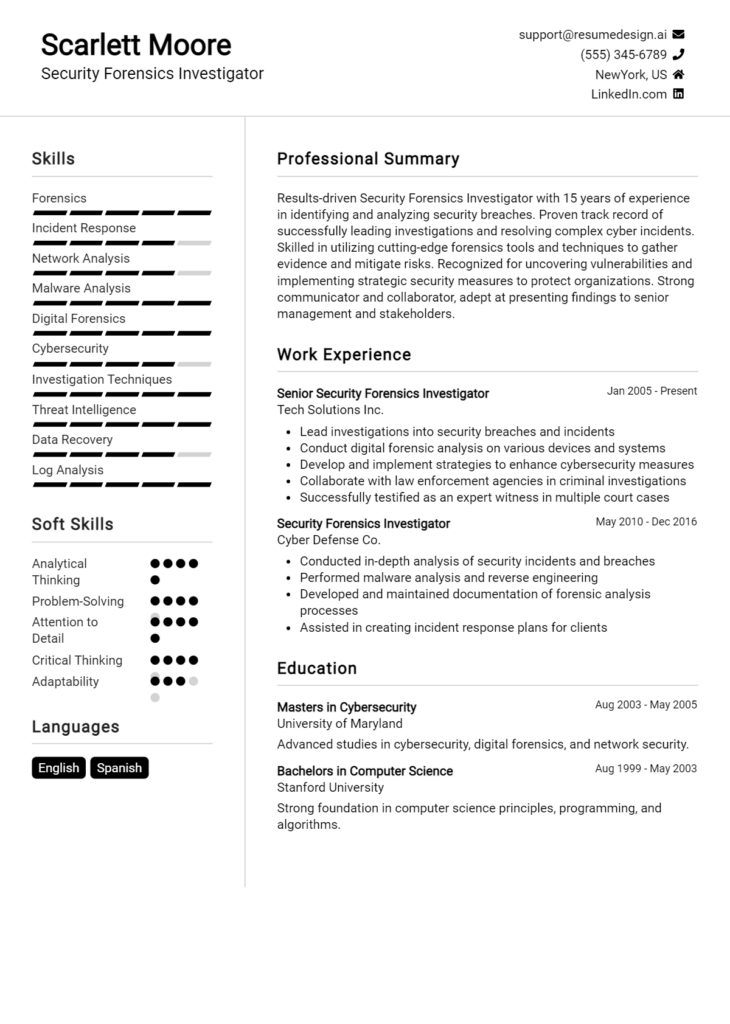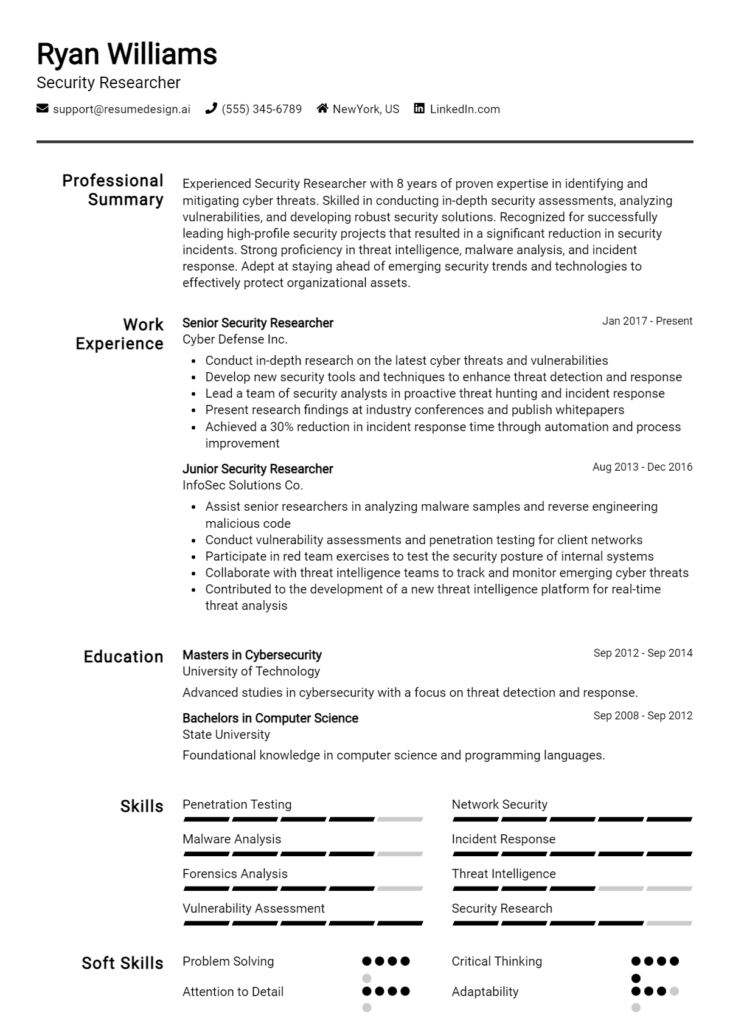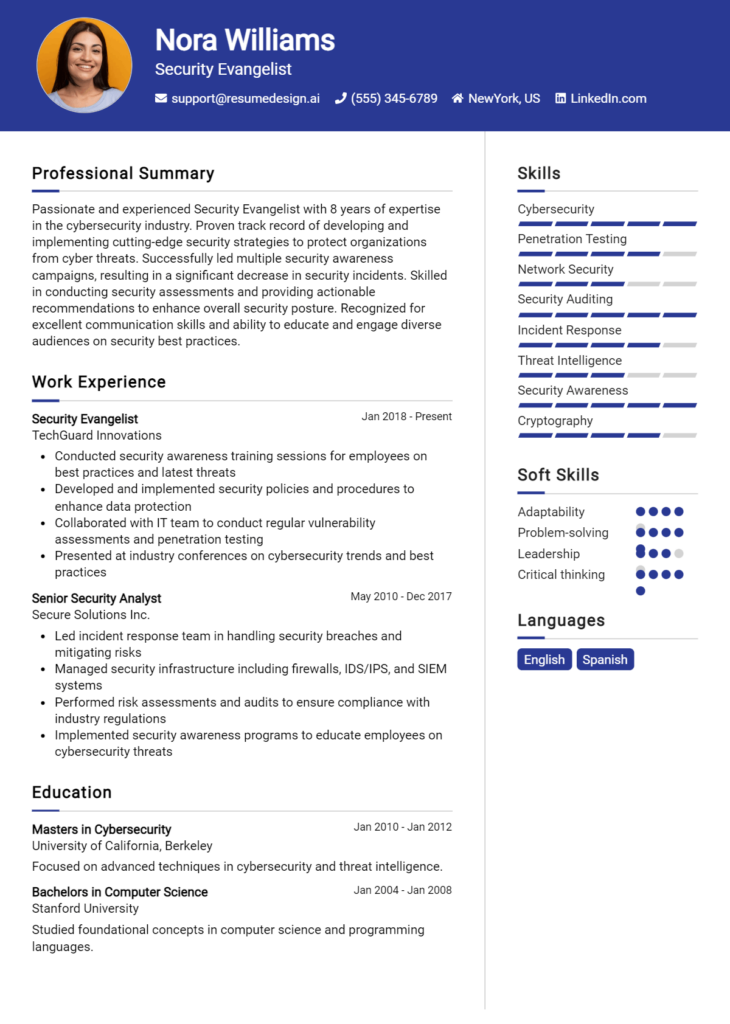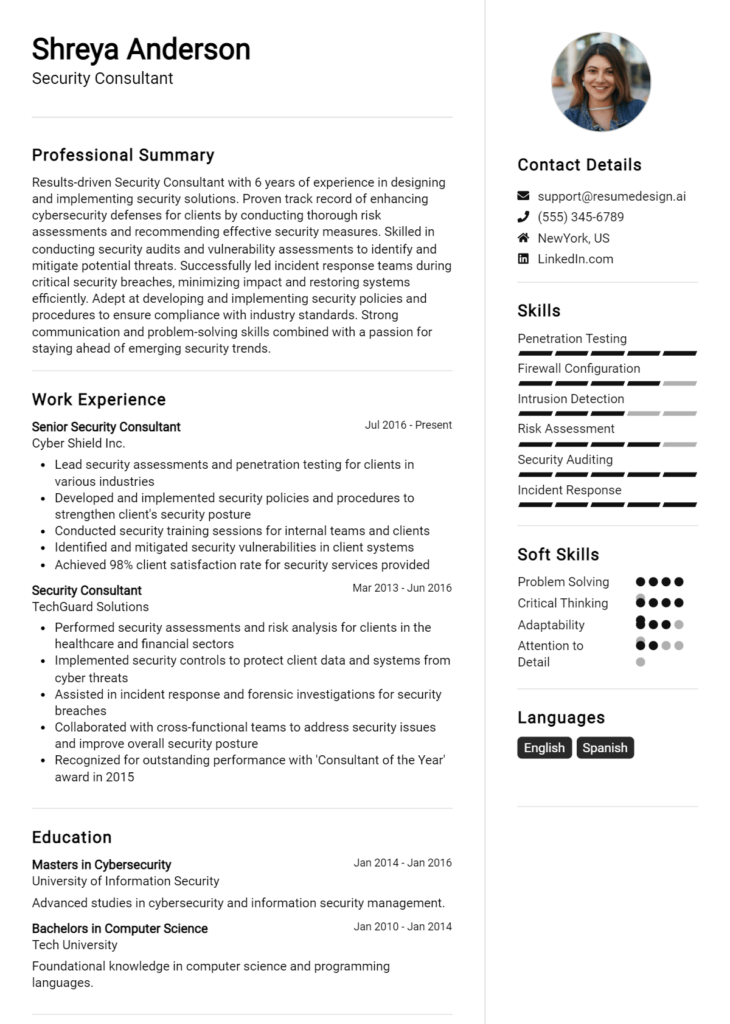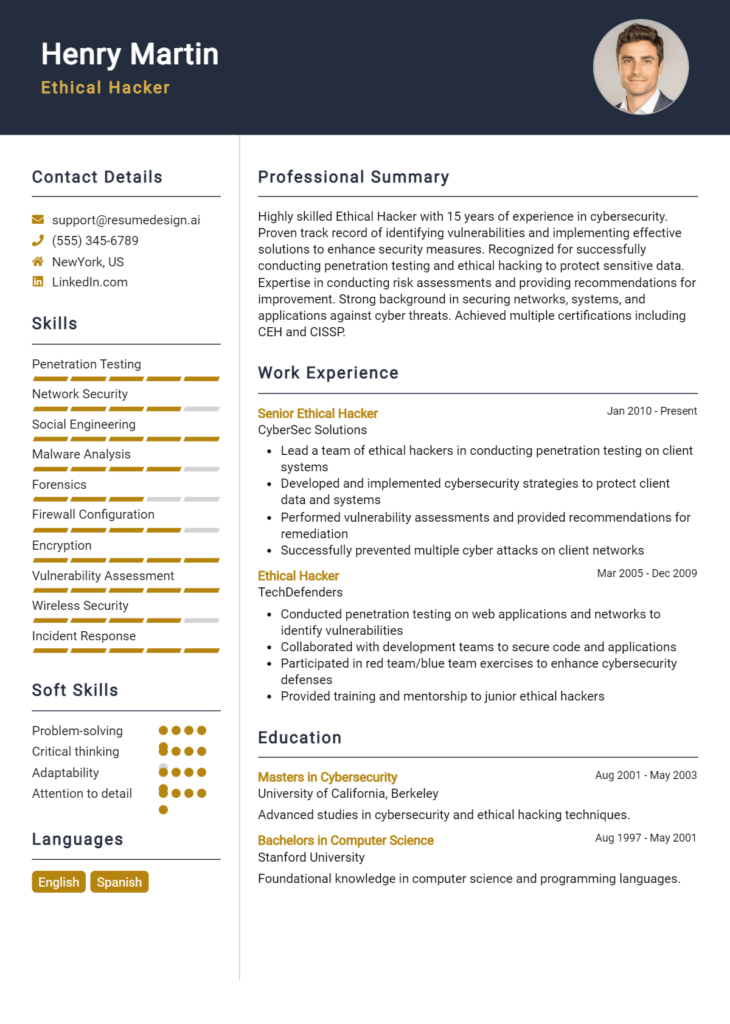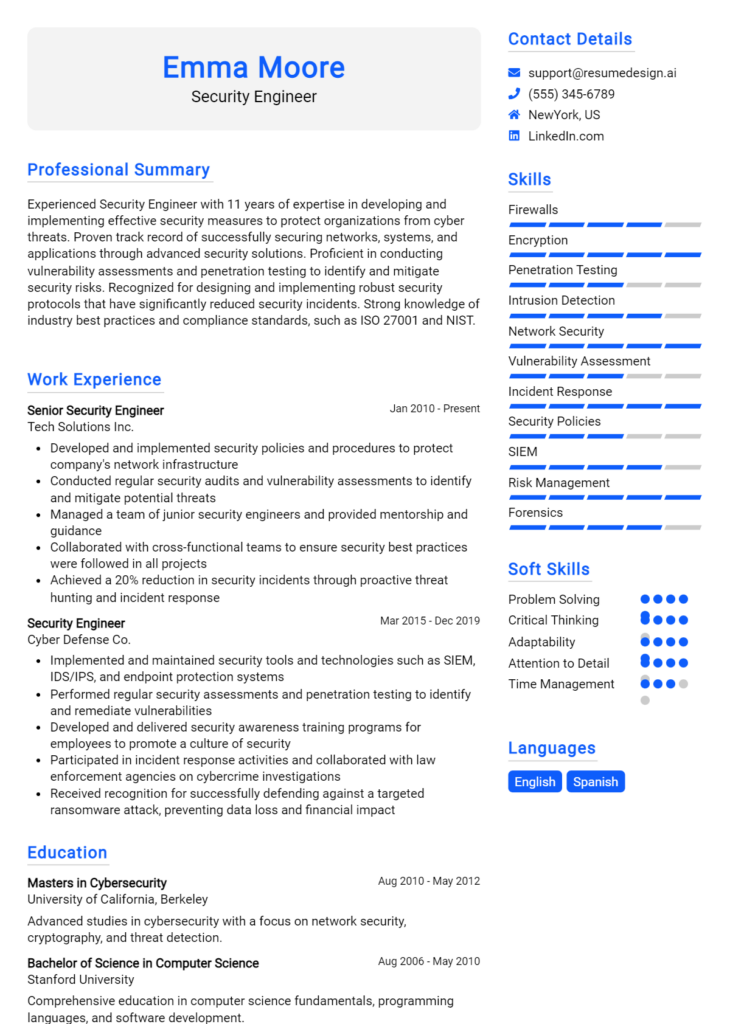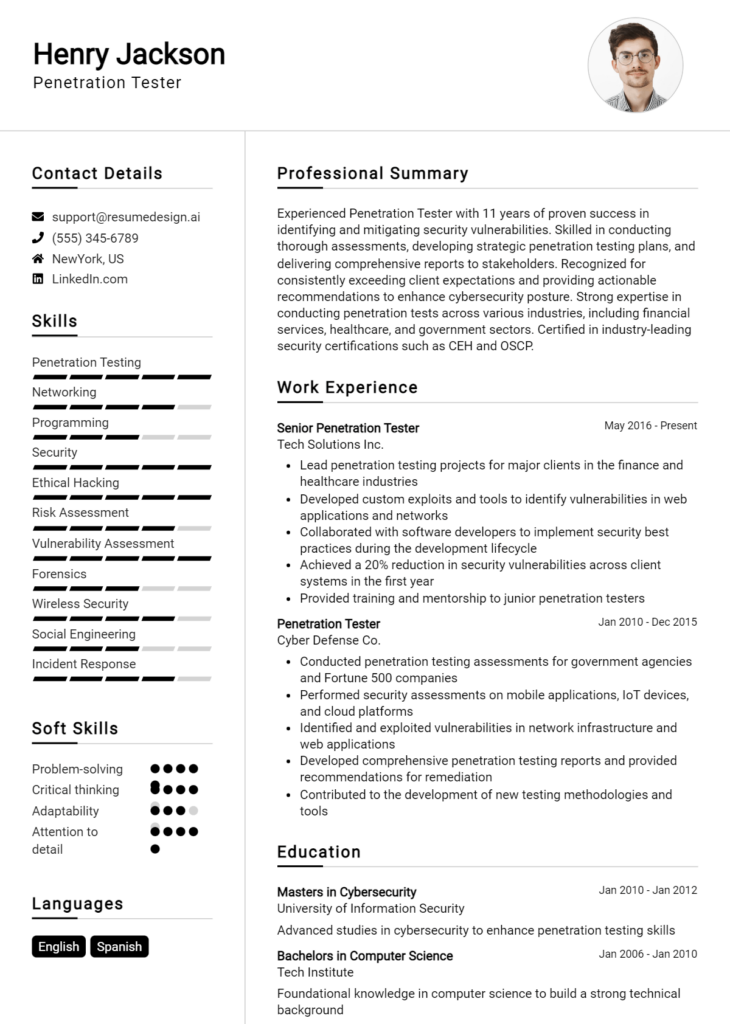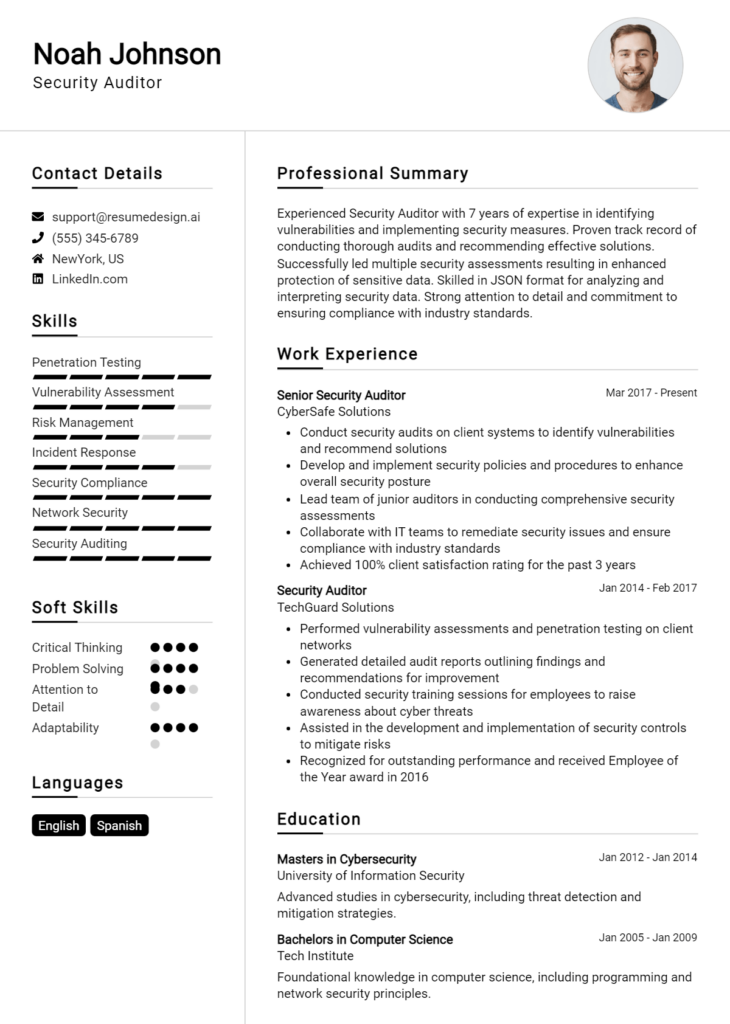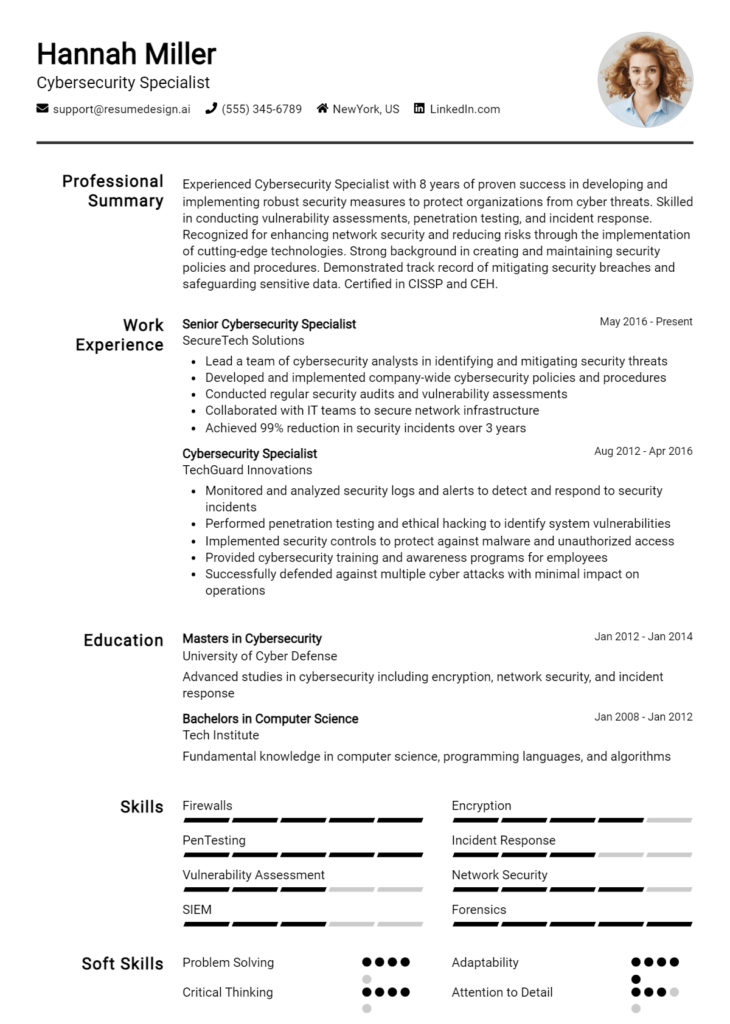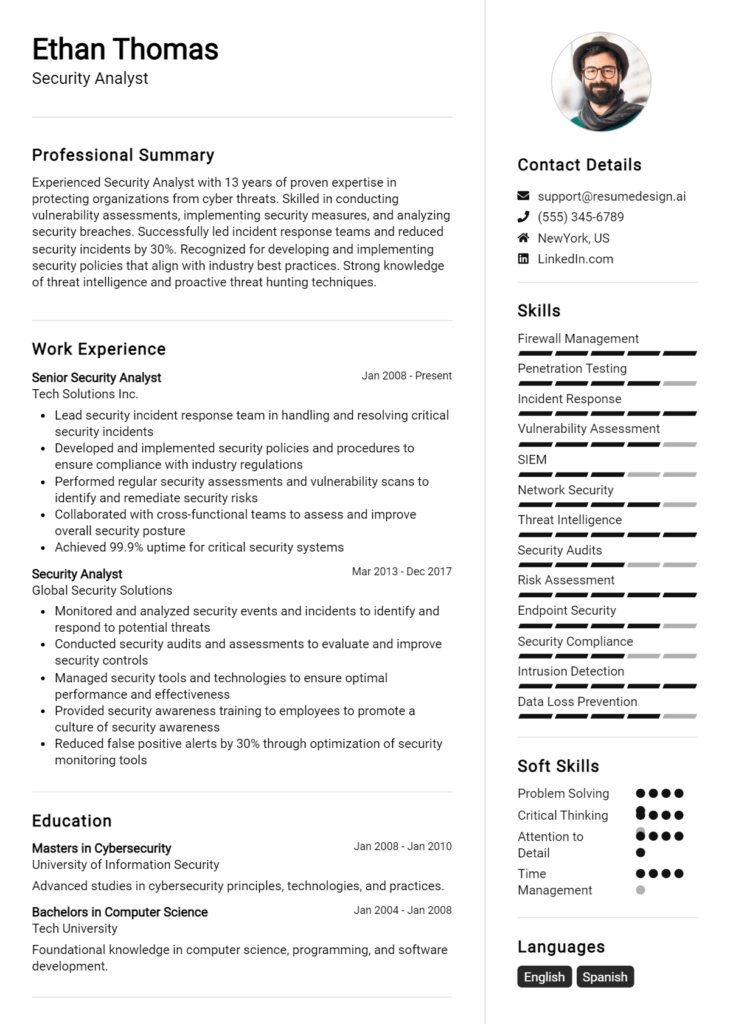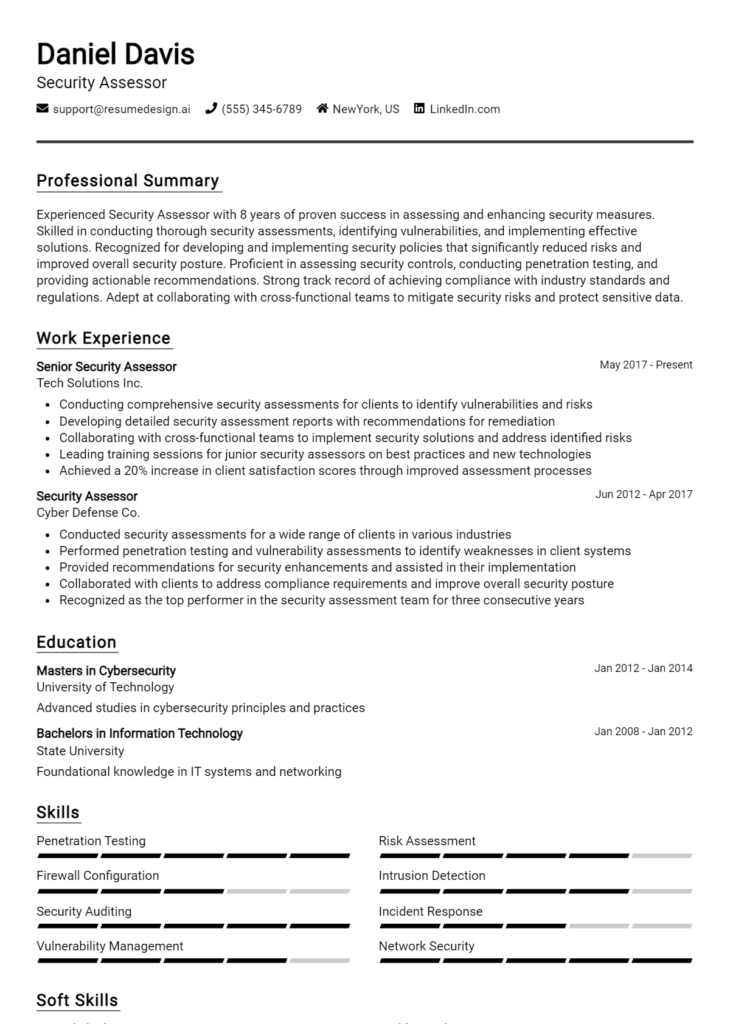Security Architect Core Responsibilities
A Security Architect is pivotal in safeguarding an organization’s information assets by designing and implementing robust security frameworks. Key responsibilities include assessing risks, developing security policies, and integrating security solutions across departments such as IT, compliance, and operations. Essential skills encompass technical expertise in security protocols, operational understanding of business processes, and strong problem-solving abilities. These competencies are vital for aligning security initiatives with organizational goals, and a well-structured resume can effectively highlight these qualifications, showcasing a candidate’s readiness to tackle complex security challenges.
Common Responsibilities Listed on Security Architect Resume
- Design and implement secure network architectures.
- Conduct risk assessments and vulnerability analyses.
- Develop and enforce security policies and procedures.
- Collaborate with IT and compliance teams to ensure security compliance.
- Monitor security systems and respond to incidents.
- Evaluate and recommend security tools and technologies.
- Provide security training and awareness for staff.
- Conduct security audits and assessments.
- Stay updated on the latest security trends and threats.
- Assist in incident response and recovery planning.
- Document security architecture and design decisions.
- Lead security improvement projects across departments.
High-Level Resume Tips for Security Architect Professionals
In the competitive field of cybersecurity, a well-crafted resume is more than just a document; it serves as the first impression a candidate makes on potential employers. For Security Architect professionals, the resume must not only showcase technical skills but also highlight significant achievements that set them apart from the competition. A thoughtfully designed resume can effectively communicate one's expertise in designing and implementing security architectures, making it a crucial tool in the job search process. This guide aims to provide practical and actionable resume tips specifically tailored for Security Architect professionals, ensuring that their resumes truly reflect their qualifications and readiness for the role.
Top Resume Tips for Security Architect Professionals
- Tailor your resume to match the specific job description, emphasizing relevant skills and experiences that align with the requirements.
- Showcase your experience in designing and implementing security frameworks, detailing the methodologies and technologies you used.
- Quantify your achievements by including metrics, such as the percentage reduction in security incidents due to your solutions.
- Highlight industry-specific certifications such as CISSP, CISM, or AWS Certified Security to demonstrate your expertise.
- Include a concise summary at the top of your resume that encapsulates your key qualifications and career goals.
- Use action verbs to describe your contributions and achievements, making your responsibilities sound impactful.
- Demonstrate knowledge of compliance standards and regulations, like GDPR, HIPAA, or PCI-DSS, that are relevant to the positions you are applying for.
- Incorporate keywords from the job posting to pass through Applicant Tracking Systems (ATS) and catch the employer's attention.
- Keep your resume concise, ideally one to two pages, focusing on the most relevant information to make it easily readable.
By implementing these resume tips, Security Architect professionals can significantly enhance their chances of landing a job in a highly sought-after field. A well-structured resume that effectively highlights relevant skills, achievements, and industry knowledge will not only attract the attention of hiring managers but also demonstrate a candidate's commitment to excellence in cybersecurity.
Why Resume Headlines & Titles are Important for Security Architect
In the competitive field of cybersecurity, the role of a Security Architect is crucial for safeguarding an organization’s information systems. Crafting a compelling resume headline or title is essential for candidates in this domain, as it serves as the first impression to hiring managers. A strong headline can effectively capture attention, summarizing a candidate's key qualifications and expertise in one impactful phrase. This succinct representation not only showcases the individual’s relevance to the position but also sets the tone for the rest of the resume. A well-crafted headline should be concise, directly related to the job being applied for, and reflective of the skills and experiences that make the candidate stand out.
Best Practices for Crafting Resume Headlines for Security Architect
- Keep it concise—limit to one impactful phrase.
- Be role-specific—tailor the headline to the Security Architect position.
- Highlight key skills or certifications relevant to the role.
- Use action verbs or strong adjectives to convey strength.
- Avoid jargon or overly technical terms that may confuse.
- Incorporate quantifiable achievements if possible.
- Ensure clarity and professionalism in wording.
- Regularly update the headline to reflect new skills or experiences.
Example Resume Headlines for Security Architect
Strong Resume Headlines
Certified Information Systems Security Professional (CISSP) with 10+ Years in Security Architecture
Strategic Security Architect Specializing in Cloud Security and Risk Management
Experienced Security Architect Driving Enterprise Security Solutions and Compliance
Innovative Security Architect with Proven Track Record in Threat Mitigation and Design
Weak Resume Headlines
Security Expert
IT Professional
Looking for a Job in Security
The strong headlines are effective because they are specific, relevant, and highlight the candidate's qualifications in a way that aligns with the needs of the hiring organization. They immediately communicate the candidate's expertise and experience while showcasing their value proposition. In contrast, the weak headlines fail to impress due to their vagueness and lack of specificity. They do not convey any unique skills or experiences, making it difficult for hiring managers to assess the candidate's fit for the role. A strong, targeted headline can make all the difference in capturing attention in a crowded job market.
Writing an Exceptional Security Architect Resume Summary
Writing an exceptional resume summary is crucial for a Security Architect as it serves as a first impression for hiring managers. A strong summary quickly captures attention by showcasing the candidate's key skills, relevant experience, and notable accomplishments in the field of cybersecurity. It should be concise and impactful, tailored to the specific job description to clearly communicate why the candidate is the ideal fit for the role. An effective resume summary not only highlights technical expertise but also demonstrates problem-solving abilities and a proactive approach to safeguarding information systems.
Best Practices for Writing a Security Architect Resume Summary
- Quantify achievements: Use specific metrics to highlight your successes, such as percentage improvements in security protocols or reduced incident response times.
- Focus on key skills: Emphasize relevant technical skills, certifications, and tools that align with the job requirements.
- Tailor the summary: Customize your summary for each job application to reflect the specific needs and keywords mentioned in the job description.
- Keep it concise: Aim for 3-5 sentences that succinctly convey your qualifications without unnecessary fluff.
- Use action verbs: Start sentences with strong action verbs to create a dynamic tone that reflects your proactive approach.
- Highlight relevant experience: Include notable past roles or projects that showcase your expertise in security architecture.
- Showcase soft skills: Don’t forget to mention critical soft skills like communication, leadership, and teamwork that are vital in collaborative environments.
- Stay professional: Maintain a formal tone and avoid jargon that may not be familiar to all hiring managers.
Example Security Architect Resume Summaries
Strong Resume Summaries
Results-driven Security Architect with over 10 years of experience in designing secure infrastructure for Fortune 500 companies. Successfully reduced security breaches by 40% through the implementation of advanced threat detection systems and employee training programs.
Innovative Security Architect possessing extensive knowledge in cloud security and risk assessment. Led a team that improved incident response times by 60% while achieving compliance with ISO 27001 standards.
Dynamic Security Architect with a proven track record of implementing robust security protocols across diverse industries. Spearheaded a project that saved the company $500,000 annually through improved data protection measures and reduced downtime.
Detail-oriented Security Architect with expertise in vulnerability management and secure software development. Instrumental in developing a security framework that decreased vulnerabilities by 70% in the first year of implementation.
Weak Resume Summaries
Experienced IT professional looking for a security architect position. I have worked in various roles and have a good understanding of security practices.
Dedicated Security Architect with experience in the field. I am eager to contribute my skills to a new team and help improve security.
The examples provided highlight the key differences between strong and weak resume summaries. Strong summaries are specific, quantifiable, and directly relevant to the role, showcasing the candidate's unique contributions and expertise. In contrast, weak summaries lack detail, specificity, and measurable outcomes, making them less impactful and memorable to hiring managers. A well-crafted summary can significantly enhance a candidate's chances of securing an interview.
Work Experience Section for Security Architect Resume
The work experience section of a Security Architect resume is crucial as it provides a detailed overview of the candidate's technical skills, leadership abilities, and success in delivering high-quality security products and solutions. This section not only highlights relevant experiences but also demonstrates how the candidate has effectively managed teams and projects in a fast-paced environment. By quantifying achievements and aligning their experiences with industry standards, candidates can clearly illustrate their value to potential employers, making a compelling case for their expertise in safeguarding organizational assets.
Best Practices for Security Architect Work Experience
- Focus on quantifiable results, such as percentage improvements in security posture or reductions in incident response time.
- Highlight specific technical skills and tools used, such as firewalls, intrusion detection systems, or encryption technologies.
- Showcase leadership and team management experiences, emphasizing collaboration and mentorship.
- Align your experiences with industry standards and best practices, such as NIST, ISO 27001, or CIS controls.
- Use action-oriented language to describe your contributions, demonstrating initiative and impact.
- Include relevant certifications and training that reinforce your expertise in security architecture.
- Tailor your experiences to match the job description, emphasizing relevant skills and outcomes.
- Provide context for your achievements by explaining the challenges faced and how your solutions addressed them.
Example Work Experiences for Security Architect
Strong Experiences
- Led a cross-functional team to design and implement a new security framework that reduced vulnerability exposure by 30% within the first year.
- Implemented a cloud security strategy that resulted in a 40% reduction in security incidents and improved compliance with industry regulations.
- Managed a team of security analysts, fostering a collaborative environment that enhanced incident response times by 50% through improved processes and training.
- Architected and deployed an enterprise-wide encryption solution that secured sensitive data across multiple platforms, increasing data protection compliance by 60%.
Weak Experiences
- Worked on security projects with various teams.
- Assisted in implementing security measures.
- Helped improve security protocols.
- Participated in discussions about security architecture.
The examples categorized as strong demonstrate specific, measurable achievements and a clear impact on security outcomes, reflecting the candidate's technical expertise and leadership capabilities. In contrast, the weak experiences lack detail and quantifiable results, making it difficult for potential employers to gauge the candidate's true contributions and effectiveness in previous roles. This highlights the importance of providing concrete examples that showcase the candidate's value in the security architecture domain.
Education and Certifications Section for Security Architect Resume
The education and certifications section of a Security Architect resume is vital as it showcases the candidate's academic background, relevant industry certifications, and commitment to continuous professional development. This section not only highlights formal education but also emphasizes specialized training and coursework that are pertinent to the field of cybersecurity architecture. By detailing these qualifications, candidates can enhance their credibility and demonstrate their alignment with the specific requirements of the job role, making them more appealing to potential employers.
Best Practices for Security Architect Education and Certifications
- Include relevant degrees such as Computer Science, Information Technology, or Cybersecurity.
- List industry-recognized certifications like CISSP, CISM, or CCSP prominently.
- Detail relevant coursework, particularly in areas like network security, risk assessment, and cryptography.
- Highlight any specialized training or workshops attended that pertain to security architecture.
- Use specific dates to indicate when degrees were obtained and certifications were achieved.
- Prioritize the most relevant and advanced credentials to align with job descriptions.
- Consider including ongoing education efforts, such as MOOCs or webinars, to showcase a commitment to learning.
- Format the section clearly and concisely for easy readability by hiring managers.
Example Education and Certifications for Security Architect
Strong Examples
- M.S. in Cybersecurity, University of California, 2021
- CISSP (Certified Information Systems Security Professional), (ISC)², 2022
- CCSP (Certified Cloud Security Professional), (ISC)², 2023
- Coursework in Network Security, Incident Response, and Security Architecture at XYZ University
Weak Examples
- B.A. in History, State University, 2000
- Basic IT Certification, 2010 (outdated)
- Coursework in General Business Management
- CompTIA A+ Certification, 2015 (not relevant for Security Architect role)
The examples provided highlight strong qualifications that are relevant and up-to-date in the field of security architecture. Strong examples indicate a focused educational background and certifications that align with industry standards and job expectations. In contrast, weak examples reflect outdated or irrelevant qualifications that do not support the candidate's suitability for a Security Architect position, potentially undermining their application.
Top Skills & Keywords for Security Architect Resume
As a Security Architect, possessing the right skills is crucial for developing effective security strategies and protecting an organization’s information assets. A well-crafted resume that highlights both hard and soft skills can significantly enhance a candidate's chances of securing interviews. The combination of technical knowledge and interpersonal abilities not only demonstrates a comprehensive understanding of security systems but also showcases the candidate's capacity to collaborate with cross-functional teams, communicate complex ideas, and adapt to the ever-evolving threat landscape. Emphasizing these skills can give potential employers confidence in a candidate's capability to safeguard their infrastructure.
Top Hard & Soft Skills for Security Architect
Soft Skills
- Analytical Thinking
- Problem-Solving
- Communication Skills
- Leadership
- Team Collaboration
- Adaptability
- Attention to Detail
- Time Management
- Project Management
- Critical Thinking
Hard Skills
- Risk Assessment
- Network Security
- Application Security
- Cloud Security
- Security Information and Event Management (SIEM)
- Identity and Access Management (IAM)
- Firewall and Intrusion Detection Systems
- Encryption Technologies
- Compliance Standards (e.g., GDPR, HIPAA)
- Vulnerability Management
For a more comprehensive understanding of how to present your skills and work experience effectively, consider integrating these elements into your resume to strengthen your application as a Security Architect.
Stand Out with a Winning Security Architect Cover Letter
I am writing to express my interest in the Security Architect position at [Company Name]. With over [X years] of experience in designing and implementing advanced security architectures, I have developed a robust skill set that aligns perfectly with the needs of your organization. My extensive background in safeguarding critical information systems and ensuring compliance with industry standards has equipped me to contribute effectively to your team and enhance your security posture.
In my previous role at [Previous Company Name], I successfully led a team to redesign our security framework, resulting in a 40% reduction in security incidents over two years. My ability to assess risks and strategically implement security measures allowed us to achieve compliance with ISO 27001 and NIST standards. I am adept at collaborating with cross-functional teams to integrate security into the software development lifecycle (SDLC), ensuring that security is not an afterthought but a foundational element of the development process.
I am particularly drawn to [Company Name] due to its commitment to innovation and excellence in cybersecurity. I am excited about the opportunity to leverage my expertise in threat modeling, vulnerability assessments, and security architecture design to help you stay ahead of emerging threats. As a proactive problem-solver, I thrive in challenging environments and am committed to staying abreast of the latest security trends and technologies, which I believe would be a valuable asset to your organization.
Thank you for considering my application. I am eager to discuss how my background, skills, and enthusiasms align with the goals of [Company Name]. I look forward to the possibility of contributing to your team and enhancing your security infrastructure. Please feel free to contact me at your earliest convenience to schedule a discussion.
Common Mistakes to Avoid in a Security Architect Resume
When crafting a resume for a Security Architect position, it's crucial to present your skills and experiences effectively. A compelling resume not only highlights your technical expertise but also demonstrates your ability to apply that knowledge in real-world scenarios. However, many candidates fall into common pitfalls that can undermine their chances of landing an interview. Avoiding these mistakes can significantly enhance the impact of your resume and showcase your qualifications more effectively.
Lack of Specificity: Vague descriptions of responsibilities can make it difficult for hiring managers to gauge your expertise. Instead, provide specific examples of projects and technologies you’ve worked with.
Ignoring Keywords: Many companies use applicant tracking systems (ATS) to filter resumes. Failing to include relevant keywords from the job description can result in your resume being overlooked.
Overemphasis on Technical Skills: While technical skills are essential, focusing solely on them can neglect the importance of soft skills. Security Architects must also demonstrate leadership, communication, and problem-solving abilities.
Omitting Certifications: Security certifications like CISSP, CISM, or CEH are vital in this field. Not listing these credentials can make your resume less competitive.
Inconsistent Formatting: A cluttered or inconsistent layout can detract from the professionalism of your resume. Ensure that your formatting is clean, organized, and easy to read.
Failure to Quantify Achievements: Providing metrics and quantifiable results can significantly strengthen your resume. Instead of simply stating your duties, highlight how your work improved security posture or reduced risks.
Neglecting to Tailor the Resume: Sending the same resume to multiple job applications can be detrimental. Tailor your resume to each position by aligning your experiences with the specific requirements of the role.
Too Much Technical Jargon: While it's important to demonstrate expertise, using excessive technical jargon can alienate non-technical hiring managers. Strive for a balance that conveys your depth of knowledge without overwhelming the reader.
Conclusion
In summary, a Security Architect plays a crucial role in safeguarding an organization's information systems and data. The key responsibilities include designing and implementing secure systems, assessing risks, and developing security strategies that align with business objectives. Staying updated on the latest security threats and technologies is vital for success in this position.
It’s essential for Security Architects to present their skills and experiences effectively through a well-crafted resume. This not only highlights their expertise but also sets them apart in a competitive job market. If you're a Security Architect looking to enhance your resume, now is the perfect time to take action.
Review your Security Architect resume today, ensuring it accurately reflects your qualifications and achievements. To assist you in this process, consider utilizing the following resources:
- Explore resume templates to find a design that suits your style.
- Use the resume builder to create a polished and professional document easily.
- Check out resume examples for inspiration and ideas on how to format your own.
- Don’t forget to craft a compelling cover letter using our cover letter templates to complement your resume.
Take the next step in your career by updating your resume today!

